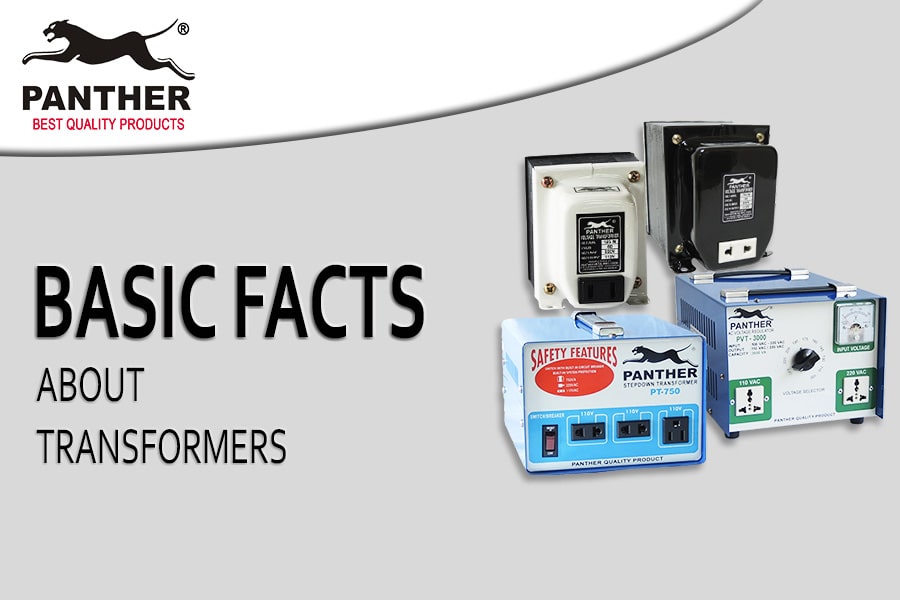
Table of Contents
- What is the purpose of a transformer (also known as a voltage converter)?
- How long will a good quality transformer last?
- How can you tell if it’s a good quality transformer?
- What’s the difference between a step-down vs a step-up transformer?
- What’s the difference between an isolation vs auto-type transformer?
While most people aren’t familiar with transformers and their usage, transformers are actually an ever-present part of our daily lives and is an integral part of how electricity power is supplied to our homes and businesses. Case in point, some of you may have heard this as the reason behind a power outage – “may pumutok kasi na transformer.” This is because high voltage power is generated in power plants far from the city, distributed across the country using a national grid network, and then converted via stepdown transformers into usable 220V – 230V required by our home appliances.

But did you know? We also need transformers to run our favorite home appliances purchased from abroad, including but not limited to:
- Kitchen appliances: KitchenAid mixers, Japan-manufactured refrigerators, coffee making machine, grillers
- Home & Living products: Humidifiers, electrical toothbrush, power tools
- Toys for your kids and grandkids
Surprised? Don’t be. As a trusted transformer manufacturer and supplier in the Philippines, we’ve set up this article to help you fully understand what is a transformer and its main function, the different ways transformers are classified (step-up vs step-down, isolation vs auto type), and how to determine what type of transformer you need.
What is the purpose of a transformer (also known as a voltage converter)?
Put simply, a transformer converts (or transforms) the voltage supplied from utility companies to your homes (also known as input voltage, which is traditionally at 220V – 230V AC for the Philippines) into the appropriate voltage requirement of your appliance (also known as output voltage)
Let us provide an example to make it easier to envision:
You purchased a refrigerator from Japan, which requires a voltage of 100V to function. Unfortunately, the Philippines’ power supply is at 220V – 230V. If you plug in your 100V transformer into the 220V – 230V plug, it will end VERY badly for your Japanese refrigerator.
As such, in order to use the refrigerator safely in the Philippines, you’d need a step-down transformer to convert the regular 220V – 230V AC power supply from your home power outlet, into the necessary 100V required by your refrigerator.
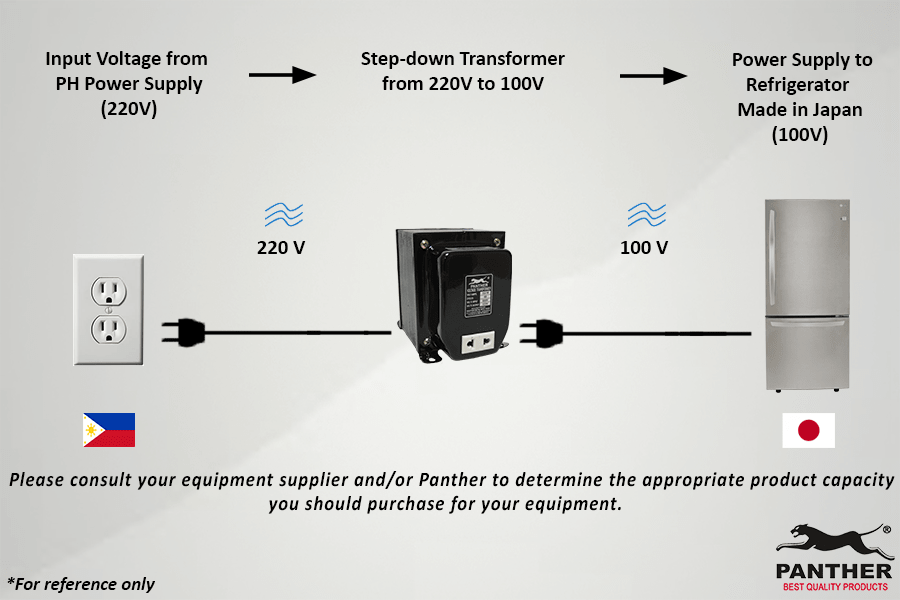
——————————————————-
How long will a good quality transformer last?
Panther has been manufacturing and selling transformers since the 1970s. From our experience, a good quality Panther transformer is meant to remain functional for a very long time. We’ve heard stories from our customers where the transformer they’re using has been passed down to them from their parents and grandparents. We’re talking three+ generations, and still going strong!
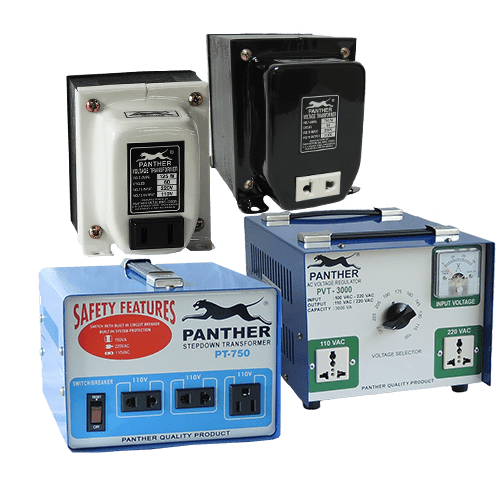
The reason for this is because transformers are static, solid-state devices that do not have any moving parts within its mechanism. So long as the proper materials are used (example: 99.9% copper) and the internal circuitry is set up properly, then a good quality transformer should perform well under normal working conditions.
How can you tell if it’s a good quality transformer?
When we say good quality, we mean safest, most reliable, and longest lasting. To help you figure out whether the transformer you’re purchasing is of good quality, we’ve listed down the features to keep an eye out for:
Coil Wiring: Material should be 99.9% Copper
Panther uses 99.9% copper for its transformer’s primary and secondary coils. Cheap transformer brands however typically skimp by using cheaper materials like aluminum.
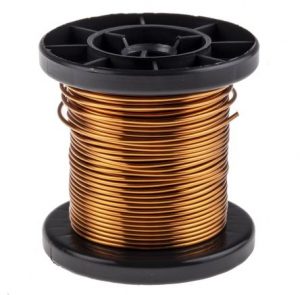
However, there’s a reason why we’re willing to pay more for copper. That’s because copper is a better conductor of electricity and has almost double the efficiency rate of aluminum! This is critical because higher conductivity means less resistance and less heat buildup – both of which is important if you want your transformer to perform its function safely.
Long story short – when purchasing transformers, make sure the material used is 99.9% copper. While slightly more expensive, it is definitely worth the trade-off in safety and performance in the long run.
Transformer Core: Material should use Silicon Steel Plates
Panther’s transformer EI cores are constructed using laminated silicon steel plates. We have chosen to do so because using a laminated silicon steel plated core vs a cold rolled steel plated core allows Panther transformer to keep its transformers running efficiently with minimal energy loss.
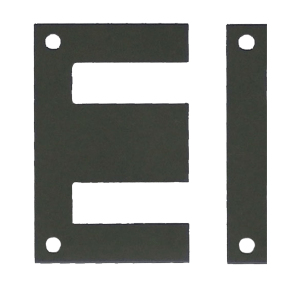
In contrast, a low quality transformer that has an inferior core would run excessively hot, and may generate an audible hum which is the result of a transformer working VERY hard under inefficient conditions due to poor quality materials used
True Rated Capacity
Panther transformers are built to match and even exceed the stated wattage capacity on the unit label. This gives you the assurance your transformer will function as stated, and will power your appliance with no fuss.
Having said that, we always advise our customers to check the appropriate transformer rating required by their equipment to ensure they aren’t buying a transformer that’s too big or too small for their needs. You can check out our transformer capacity calculator article to determine the transformer wattage you require.
Right-sized cord
There is no one-size-fits-all wire gauge for all transformers, as this will depend on your transformer capacity. The critical thing for you to remember is this: the lower the wire gauge number (also known as AWG), the thicker the copper wire inside the cord which means greater capacity for power delivery.
For example: If you’re looking at a 500W transformer, then at least an AWG #18 wire should be used.
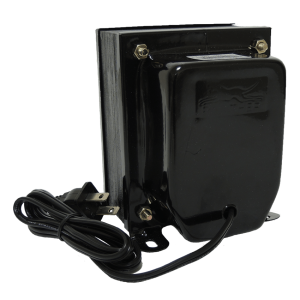
Sturdy Construction and Build
Panther transformers are visibly sturdier and heavier in construction. They are “industrial” in design as they’re meant to be solid, no frills, no BS products that will function as advertised, using the best materials and workmanship available. What you see is what you get, and that’s perhaps the best guarantee available.
Philippine-built quality and expertise
Panther has been a trusted local manufacturer of transformers since the 1970s. Not only are they designed by Filipino engineers, but Panther transformers are built specifically for the Philippine market, which means it should be targeting the specific pain points your transformer is meant to solve.
Lifetime Service Warranty

Because we believe in the quality of Panther transformers, we provide Lifetime Service Warranty on ALL Panther transformers. Under normal circumstances and treated properly, Panther transformers are meant to last you a lifetime, and that’s why our warranty also has a lifetime guarantee.
This means regardless of when or where you purchased it, we are happy to provide servicing of your transformers free of charge. Replacement parts will be charged at cost, however.
What’s the difference between a step-down vs a step-up transformer?
The key words here are STEP-DOWN and STEP-UP. Essentially, think of it in terms of the desired movement in voltage from the power outlet’s voltage supply to your appliance.
Function of a Step-down transformer, with illustrated example
A step-down transformer brings DOWN the voltage, so that the voltage supplied to your equipment is LOWER than the original voltage supply from the power outlet. You need this if your appliance’s voltage requirements is LOWER than the normal voltage supply
For example: You bought a Kitchenaid Mixer from the US, where the voltage requirement is 110V. The Philippines voltage supply is 220V – 230V however. As such, you need a step-down transformer to STEP DOWN the input voltage (from 220V of the Philippines power supply) into the appropriate output voltage needed by your equipment (to 110V requirement of your US Kitchenaid mixer)
Result: Input voltage of 220 V (from Philippines voltage supply) is stepped down to 110V (equipment requirement)
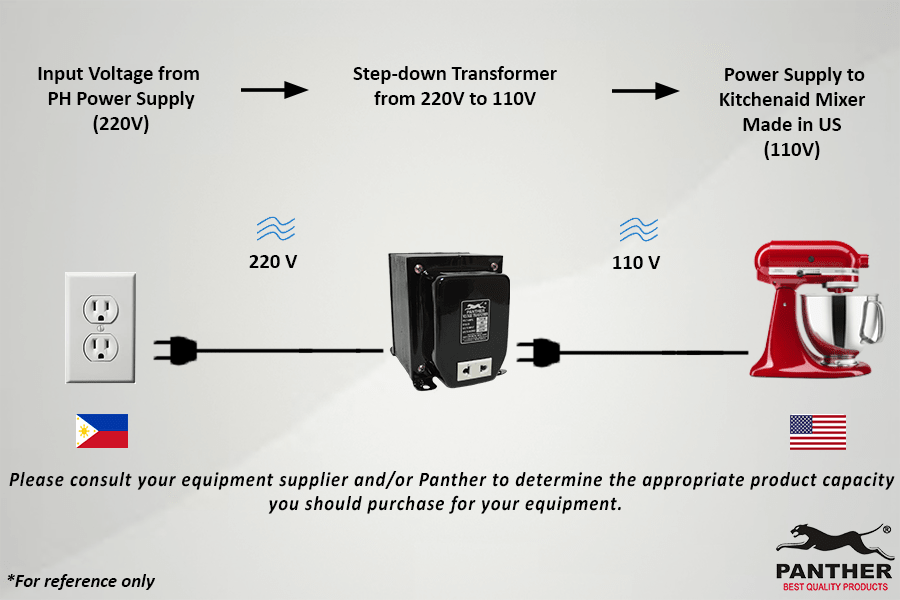
Function of a Step-up transformer, with illustrated example
A step-up transformer brings UP the voltage, so that the voltage supplied to your equipment is HIGHER than the original voltage supply from the power outlet. You need this if your appliance’s voltage requirements is HIGHER than the normal voltage supply
For example: You migrated to the US, where the voltage supply is 110V – 120V. When you migrated, you brought along your Philippine-bought PS4, which has a voltage requirement of 220V. As such, you need a step-up transformer to STEP UP the input voltage (from 110V – 120V of the US power supply) into the appropriate output voltage needed by your equipment (to 220V requirement of your Philippine-bought PS4).
Result: Input voltage of 110V – 120V (from US voltage supply) is stepped up to 220V (equipment requirement)
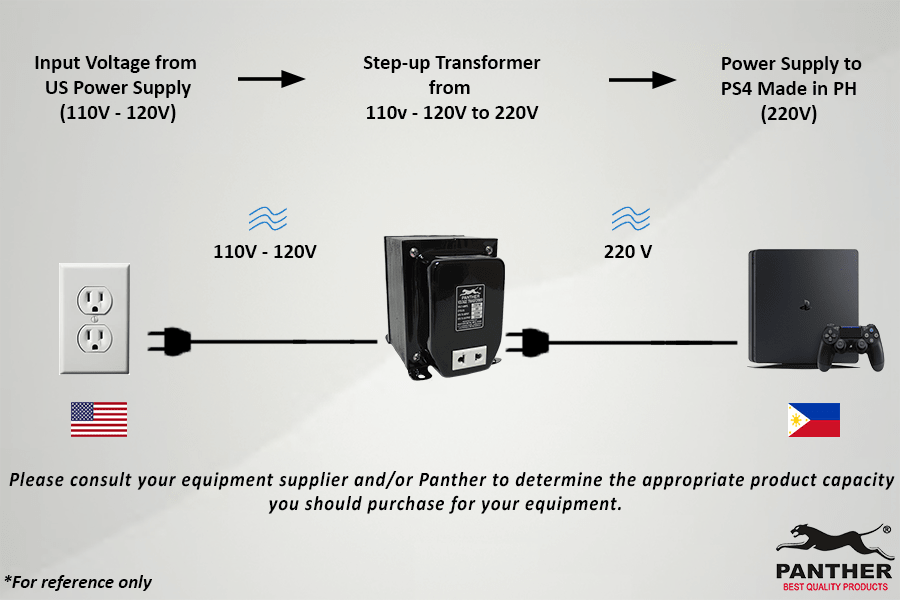
What’s the difference between an isolation vs auto-type transformer?
The main difference between isolation and auto-type transformers is in how the primary and secondary windings are insulated or not insulated from each other. Each has its advantages and disadvantages, as we will share below.
Isolation transformer
What is an isolation transformer?
It is considered an isolation transformer if its primary and secondary windings are electrically separated from each other but connected magnetically
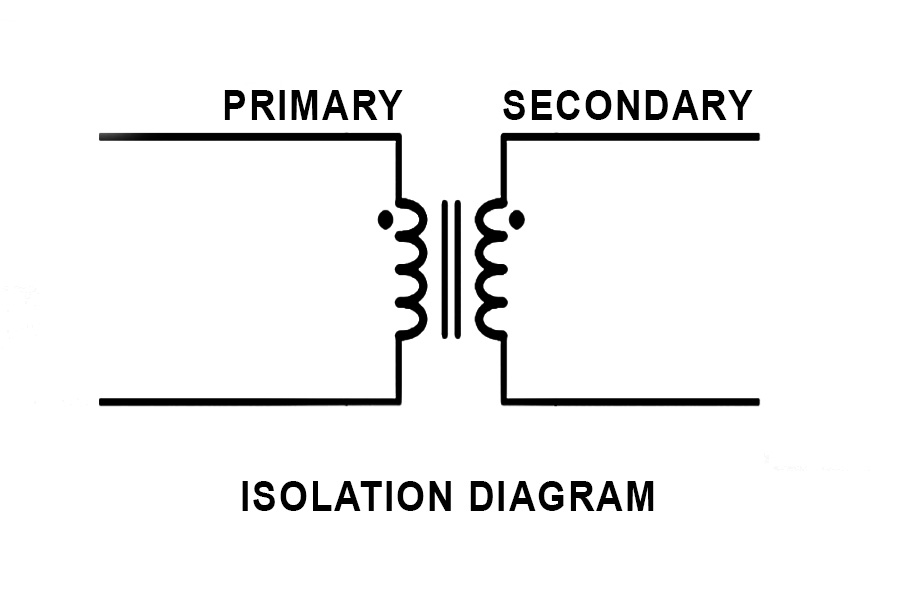
What are the advantages of an isolation transformer?
The main benefit of input-to-output isolation is as follows:
- Because the transformer’s secondary circuit is isolated from grounding, it essentially provides safety and protection to both the appliance and the person against electric shock and other ground noise
- Electrical noise can be reduced, as the isolation transformer acts as an inductance, or barrier to high frequency signals
- Because the windings are separate, isolation transformers can have completely different amperage in the primary vs secondary winding. This is especially useful if the output voltage is significantly lower than the input voltage
What are the disadvantages of an isolation transformer?
Because the windings are separate and insulated from each other, it is more costly to manufacture, and is also bigger and heavier in size
Auto-type transformer
What is an auto-type transformer?
It is considered an auto-type transformer if the primary and the secondary windings are connected magnetically AND electrically (shared winding)

What are the advantages of an auto-type transformer?
Due to the shared winding, you can expect auto-type transformer to be cheaper, smaller in size and lighter, as well as have better regulation and higher efficiency given elimination of losses in the secondary winding
What are the disadvantages of an auto-type transformer?
However, also because of the shared windings:
- Auto-type transformers are not recommended for high voltage to very low voltage transformers, as you would share the same amperage across both windings. As such, it is more commonly used for moderately small voltage changes
- The risk of electrical shock cannot be eliminated despite grounding the primary winding, since there is no electrical isolation between windings.
Where can you purchase good quality transformers in the Philippines?
Panther transformers have been in the market since the 1970s. Its longevity in the market is a direct tribute to the quality workmanship and materials that have gone into these transformers. Today, Panther transformers are available nationwide through local hardware stores (incl. DIY, True Value, Hardware Exchange, Ace Hardware) as well as through online retailers (Shopee & Lazada).

Knowing that the needs of the market can differ depending on the actual usage, we offer an expanded range of transformer products:
- Step-down transformers
- Step-down transformers w/ dual voltage
- Step-down transformers w/ switch and fuse
- Step-up transformers
- Variable transformers
- Adapter transformers
If our readily available transformers do not match your requirements, we can also manufacture made-to-order transformers for you. Simply message us your transformer requirements through our Contact Us form.


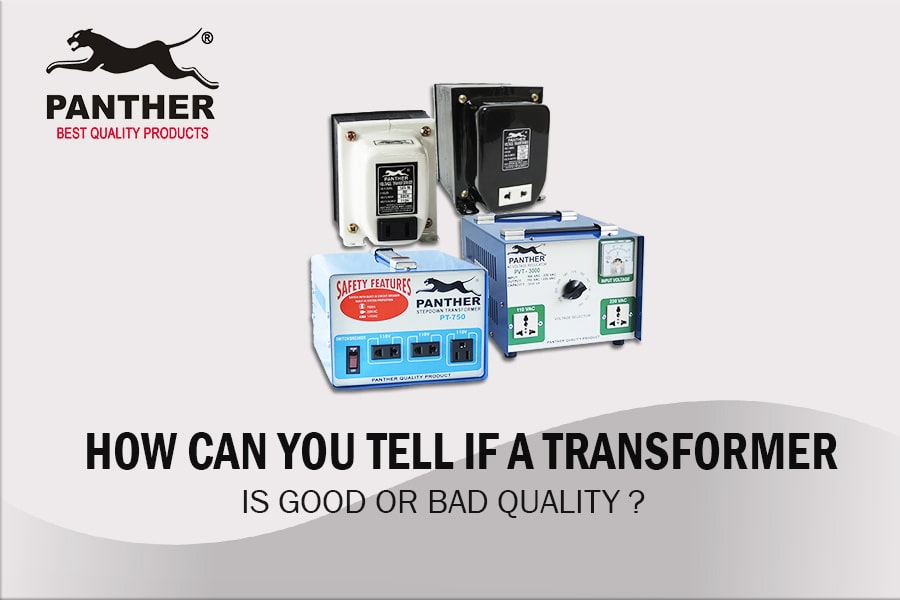
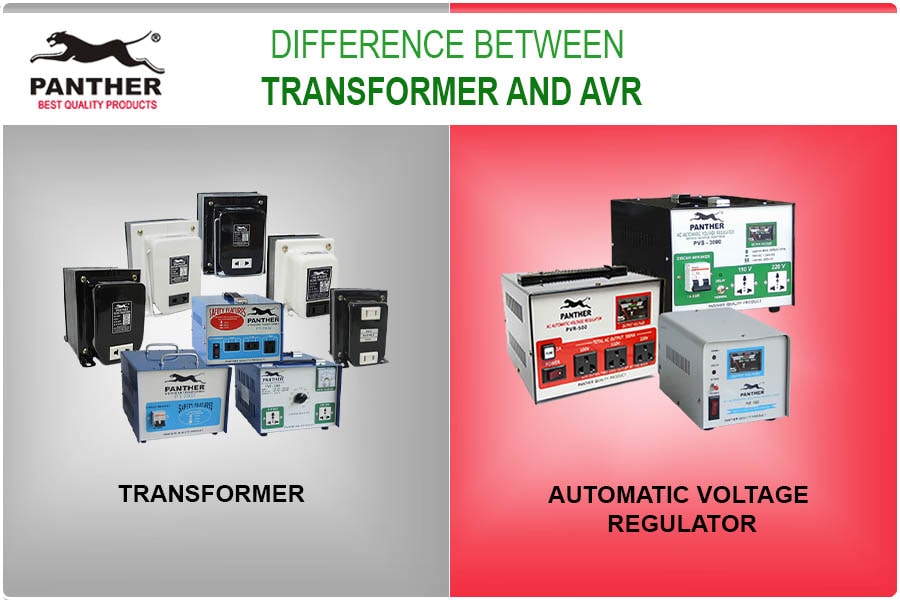
I have an oil cooled 1to1 transformer for my complex I use approximately 60 kva of power .why do I need a transformer rather than feed directly from the grid
Good day! If you already have an oil-cooled 1-to-1 distribution transformer which supplies the power at the voltage you require, then you won’t need another set of transformers.